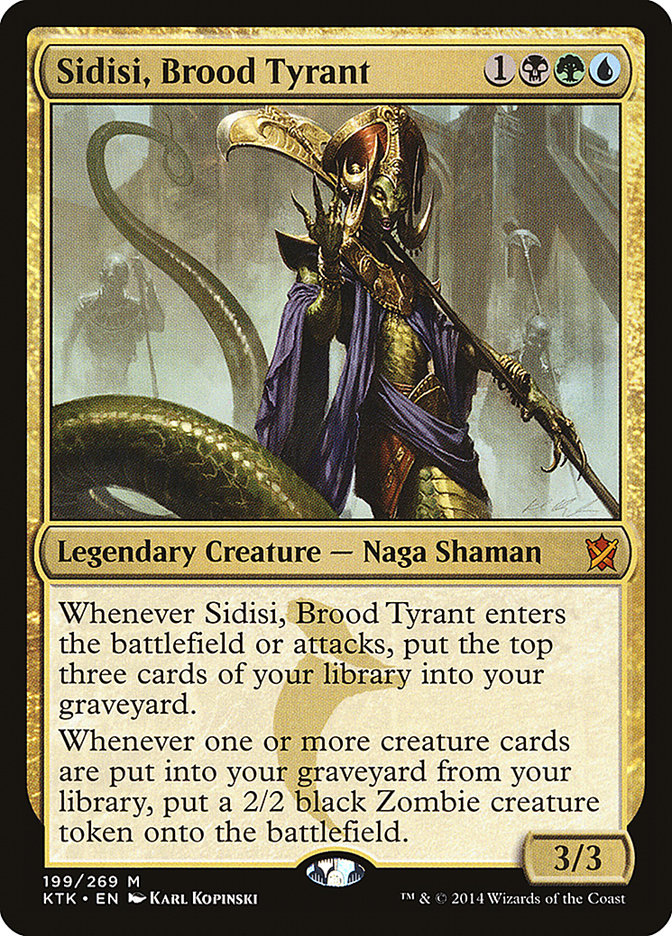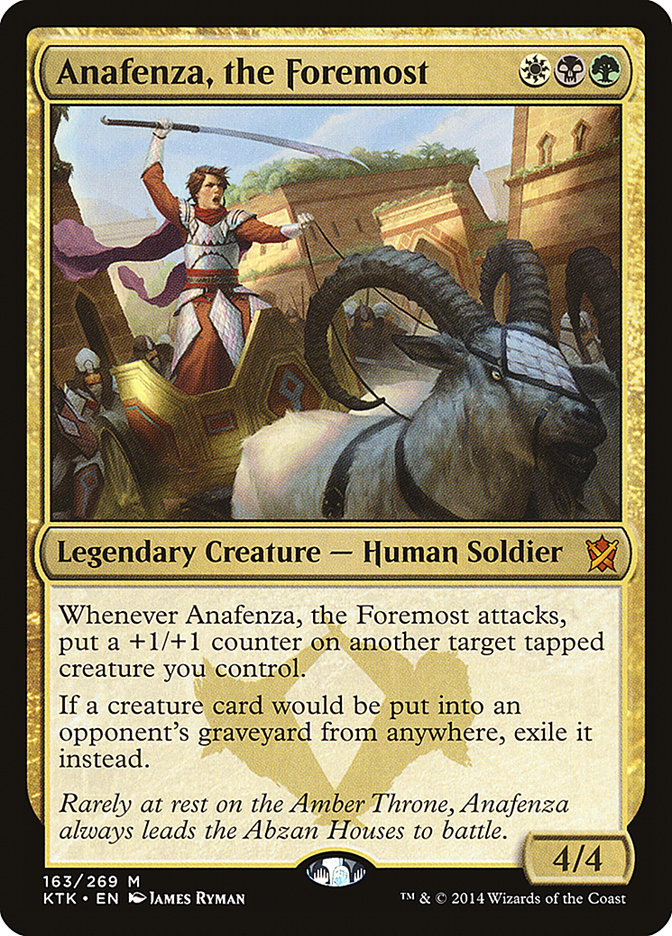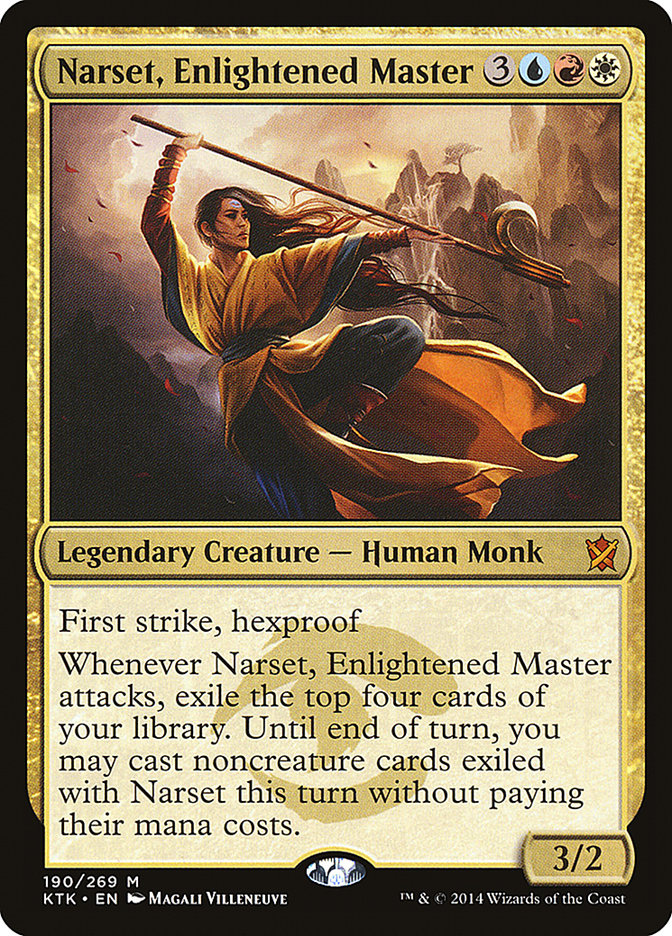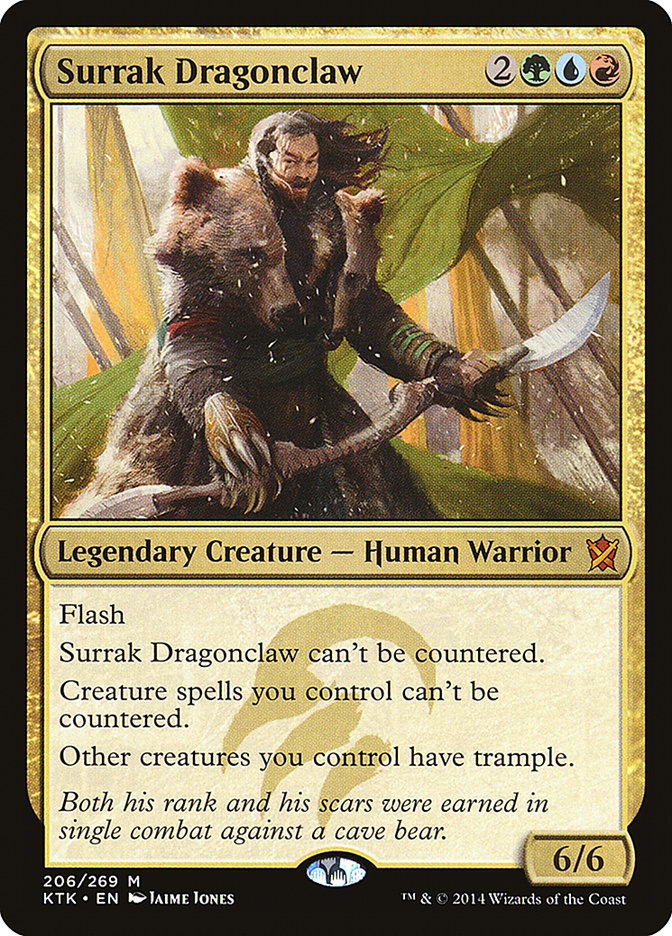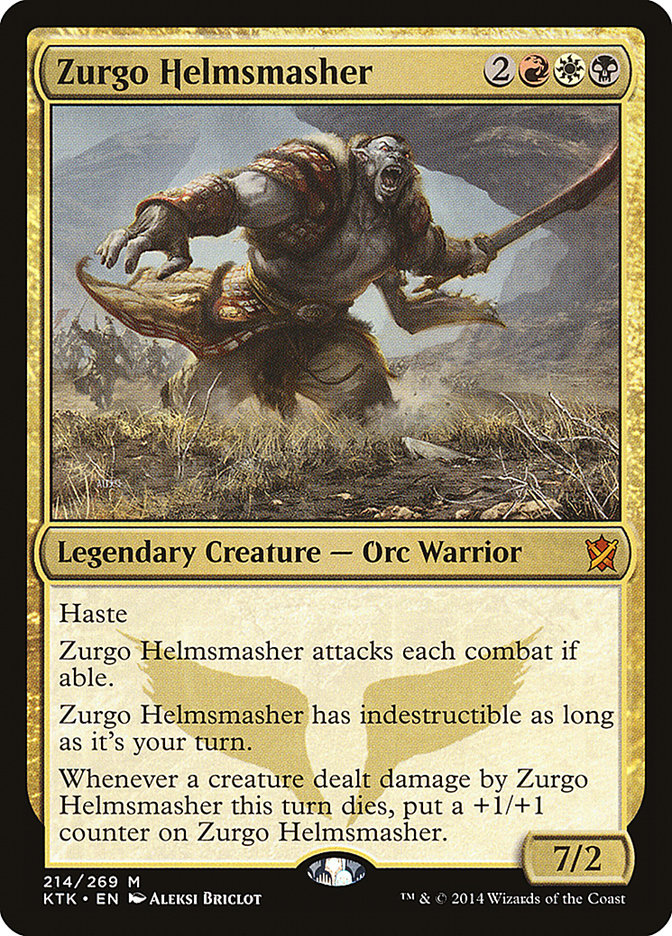“It’s not you, it’s me.”
“You’re talented in…different areas.”
“No, Matt, we’re not going to let you drive the car, you’re thirteen for heavens’ sake.”
Disappointment. Rejection. “Greater good.” We’ve all heard these words from those we love. Sometimes these words sting more than others, but we get by and
we press on to another opportunity. Based on a recent push by Wizards, we do it in every set. With the introduction of so many new legendary creatures to
use both in Standard and Commander, we can get our hopes up pretty high for each one. They often have a lot of flavor, representing his or her or its
colors with a certain unique finesse. Development and design meet happily together in a legendary creature.
Khans of Tarkir brought us five clan leaders, each representing their three color wedge as best as possible. Of the five, three have increased in cost or
stayed roughly the same since their spoiling in September, and for good reason; the best Khans are efficient, powerful, or both.
Sidisi is probably the best example; this Naga has made millions of milled creatures into 2/2 Zombies, and she isn’t slowing down. At the efficient cost of
four mana, she provides midgame and lategame potential, and building around her is fun and rewarding.
People miss Loxodon Smiter, and casting this feels on par with the Elephant, thanks to all the extra text that’s only occasionally relevant. Anafenza has
become a very maindeckable sideboard card, and her ability to smash and pump your team speaks to her power, versatility and, in the mirror with the
aforementioned Sidisi, hate.
The kung-fu monks of Jeskai call Narset master, and her potentially backbreaking attack trigger, “tron”-ability in Commander, and the hexproof and first
strike stapled on make Narset the complete package. Because of her expensive casting cost, three-color cost, and protection for targeted removal, both
100-card and 60-card lists tend to only run one, keeping her price in check.
This leaves two Khans that “didn’t have what it takes.”
For many, Surrak is the more disappointing of the two. At his height, Surrak was nearing $20.00 here on StarCityGames, but after weeks of Standard events
and no successful finishes for the mustachioed marauder, he retains only a third of his original asking price. Poor Surrak; there was a time when a 6/6
uncounterable flash creature for five would have taken the cake on its own. Giving the team uncounterability and trample should be just gravy,
right? As we’ve seen, this still doesn’t cut the mustard. I must be hungry…
Alas, Surrak’s seen little to no play in his short tenure, but I think it might be because he doesn’t slot in as easily as some of the other khans. Sidisi
is a natural fit for Sultai, and Narset loves to cast noncreature Jeskai spells.
Never fear; Surrak will have his day!
Creatures (30)
- 1 Hornet Queen
- 4 Elvish Mystic
- 1 Nylea, God of the Hunt
- 1 Titan of Eternal Fire
- 1 Karametra's Acolyte
- 4 Prophet of Kruphix
- 1 Kiora's Follower
- 4 Prophetic Flamespeaker
- 4 Yisan, the Wanderer Bard
- 1 Reclamation Sage
- 4 Rattleclaw Mystic
- 4 Surrak Dragonclaw
Lands (22)
Spells (8)

The core of the deck is its creature base, many of which you’ll notice are humans. Temur (and most colors) are full of the little hominids, so let’s tackle
this list, but we’ll do it a bit backwards, highlighting the spells first.
Spells
There’s just two playsets here, but each has its role to play. Temur Ascendancy, an innately powerful but underutilized enchantment, makes every main phase
a potentially deadly affair for your opponent. Every creature you cast can tap immediately, and the big ones can tap immediately and grant you
another card, which you might be able to cast. You’ll notice that many creatures in the list have less than four power, but check out the next spell!
Obelisk of Urd plays on the heavily human theme; if you have an Obelisk out and a two-power human comes into play, it will trigger the “four or greater”
rule for the Ascendancy, meaning nearly every creature can cycle and attack as a four-power creature right away. I do love me some haste and card draw, so
let’s slap it together with these bruisers!
Creatures
Elvish Mystics are still important despite their elven disposition, and there are going to be lots of decks that function solely on the back of this
critter on one. Moreover, he’s a nice tool when morphing Rattleclaw Mystic, a conveniently human mana dork who can get in the red zone respectfully.
Prophetic Flamespeaker, which I thought for sure was an elemental, benefits from the pump of the Obelisk and from the ability to draw a lot of cheap
creatures. Yisan, the Wanderer Bard was played in a list similar to this when Reid Duke rocked Temur the first couple weeks of the new Standard, if I
recall. Alongside Prophet of Kruphix, you can get multiple activations and multiple counters between turns, letting you seek up the biggest and best more
quickly. On that note, Surrak himself features as a four-of. Much like the Prophet, Surrak is prone to immediate removal. With black decks sporting Hero’s
Downfall and Murderous Cut, chances are they’ll slash away at Surrak the moment he appears, so having another one in your hand, perhaps one you could cast
right away, might eliminate this problem. I don’t like the “dies to removal” argument, but because Surrak doesn’t have a triggered ability, there has to be
some assurance that he’ll be getting red in the next combat.
From here a handful of singletons round out the list. Kiora’s Follower, a fifth copy of Rattleclaw Mystic, can also make one of your enormous creatures
vigilant in a pinch. Karametra’s Acolyte can generate a bounty of mana given this deck’s heavy green focus, and it gives Yisan a search target in an
otherwise empty mana cost bracket. Titan of Eternal Fire, a flavor-heavy but poorly matched finisher, can land immediately and give you burn against your
opponent’s high life total. Once you untap (hopefully during their untap step with Prophet of Kruphix), tap the team again, cooking their best
creature or their face medium well. Reclamation Sage, although not a Human, seems like an auto-include for any tutor deck. Nylea, God of the Hunt, actually
stacks up similarly to Surrak himself, offering similar size and abilities and another four-drop search. Finally, Hornet Queen sits on the top of the
stack. Cast the Queen, then cast your Obelisk (for one mana) calling Insect and watch your opponent squirm.
The sideboard offers a way to leverage your blue in Swan Song. You may not always have a full stack of mana ready to counter that removal spell or sweeper,
so Swan Song lets you edge around that. Trust me, giving them a Wind Drake that you’ll just run over is a small price to pay when you’re protecting your
team from an untimely End Hostilities. Bear’s Companion is a great two-for. With an Obelisk out, both are 4/4s, giving you two Temur Ascendancy
triggers. Unlike Surrak, Bear’s Companion gives you something if it gets axed right away. It feels like a really bad Huntmaster of the Fells,
which I’d play about 5,481 copies of if they were legal. More Reclamation Sages and Titans fill in when needed (heavy control decks and low-removal decks
respectively), and three singletons round out the end. With everyone having trample, adding deathtouch makes your creatures nearly unblockable. The steady
lifegain or Stream of Consciousness ability might also help in a pinch. Setessan Starbreaker is a Human that impersonates Reclamation Sage, killing Chained
to the Rocks, a Boon Satyr, or a Herald of Torment that’s giving you grief. Finally, I like a single Archetype of Aggression. It’s a Human, and it offers another way to give your team trample. That may seem redundant, but its ability to remove trample can shut down mono-green decks that
rely on Polukranos + Nylea to close out a game. It’s searchable, so why play more than one?
Surrak’s abilities are very powerful, but he might just need the right group of friends to realize his talents. This midrange/toolbox deck might be just
what the shaman ordered.
We’re talked about four out of five of the set’s khans, so how about número cinco?
If you’ve been watching much of the Standard coverage, Zurgo hasn’t been smashing many helms. What gives? A positive power-to-cost ratio, haste, and
indestructibility all seem like great reasons to start him. He was the first khan to appear thanks to the Speed vs. Cunning Duel Deck, with an alternate
art besides. While some of his two-dollar price tag can be attributed to early, familiar exposure, there’s got to be something that we can do with this
bruiser.
To me, he feels like a mix between Gideon, Champion of Justice and Ruhan of the Fomori. His indestructibility plus his constant attacking might hint at an
aggro deck, but in my mind, I see Zurgo much differently. Mardu is averagely popular as a clan, I’d say, and aggro and midrange builds are common with this
wedge. What if we push it all the way to the slow edge? Where would we find ourselves?
Creatures (4)
Lands (25)
Spells (31)

That’s right; we’re looking at a control deck with a set of Zurgo as the win condition, impervious to sweeper and destruction effects the moment he comes
in. Bring on the heat!
Many of the spells are redundant, so I’ll just focus on them in groups.
Removal
Crackling Doom has been a card that I’ve been impressed with time and time again. Sacrificing your highest-power creature sounded worse in print than it is
in practice. Three mana instantly answers this biggest threat, no matter how many Gods Willings, Jeskai Charms, or Ranger’s Guiles they have at the ready.
Hero’s Downfall has become the staple midrange and control removal spell, what with all these creatures and planeswalkers floating around. Anger of the
Gods and Fated Retribution answer two different decks, but both are the best card you can draw against them when you’re behind. Both can be mainphased with
Zurgo out, who doesn’t even blink as his enemies are swept away. Thoughtseize can take away a threat, sure, but it can also Duress their answer for your
Zurgo. With a seven-power smasher coming in every turn, your opponent will be in a hustle to find the answer. Despise is just Hero’s Downfall on turn 1;
most of the time, you’ll want to cast it as soon as you draw it.
Utility
The ability to scry and be cast with less particular mana make Read the Bones our preferred draw spell over Sign in Blood. The ability to see up to four
cards (if you scry to the bottom) is really strong, and I’ll pay two life for that all day. Mardu Banner makes a non-ramp deck jump from three to five, and
late game, you can cycle it, albeit for a six-mana investment. The format is slow enough that this will be decent against any non-Rabblemaster deck, plus
you can cast Throughtseize right off the Banner. Mardu Charm is exactly what I want to be doing here. It can smack down a Courser of Kruphix or
Brimaz, King of Oreskos. It can give you two creatures against a crippled opponent or lets you three-for-one them (if they attack with two one-toughness
creatures) and, perhaps most importantly, it’s an instant-speed Duress that can give you perfect information the turn before you cast your Zurgo. There
isn’t a deck where this is a bad spell.
Finishers
Four Zurgo might seem like a lot, but control and midrange decks have gotten pretty clever in the fight against sturdy creatures. Banishing Light, Chained
to the Rocks, and even a mainphased Drown in Sorrow or Hero’s Downfall are enough to send Zurgo packing. Thus, you want as many copies as you have so the
moment you’ve lost one, another can replace him. This also explains Whip of Erebos, which gives you, in effect, four temporary copies of Zurgo. Empty the
Pits is an alternative; because of the spell-heavy nature of this deck, it will be easy to achieve a one-turn kill with Zombies. All the better if Whip
backs them up!
Sideboard
Stain the Mind seems like an obvious choice in today’s sideboard with the resurgence of blue/black and blue/white control strategies that use one or two
threats to get the job done. Arc Lightning smashes up early critters very well; you won’t point it at the face much, but that option’s there if you need
it. Glare of Heresy seems to be a largely forgotten sideboard staple from Theros Block. Having a hard, permanent answer for Elspeth, Sun’s Champion, any
white God, Brimaz, Banishing Light, and Siege Rhino shouldn’t be underestimated. Anger of the Gods and Fated Retribution side in depending on the match; if
it’s fast, Anger. If it’s slow, Fated Retribution. A Perilous Vault kills all the things; for decks that rely on noncreature permanents to control
and/or win, this is the unbeatable answer to their strategy. Note that nothing, not even Zurgo, survives the activation, so it should be just a doomsday
device.
One final note about this deck: unlike other versions of slow, grindy Mardu decks, this one does not contain any planeswalkers. Most control lists I’ve
seen in these colors feature several copies each of Sarkhan, the Dragonspeaker or Elspeth, Sun’s Champion and even Sorin, Solemn Visitor. Doing this is
great, but it imposes a pretty hefty barrier to many who can’t afford or, in many cases, can’t find several loose copies floating around their shop. This
deck is certified walker-free. Besides, you’d blow ’em up half the time anyway.
How have you used your two lonely Khans? Have you found a way to leverage your end step to make Surrak more attractive? Does Zurgo have a place in a more
aggressive strategy, or is it this strategy or bust?

